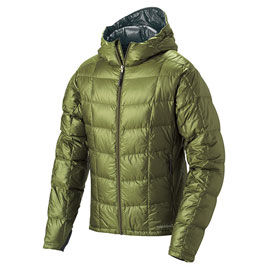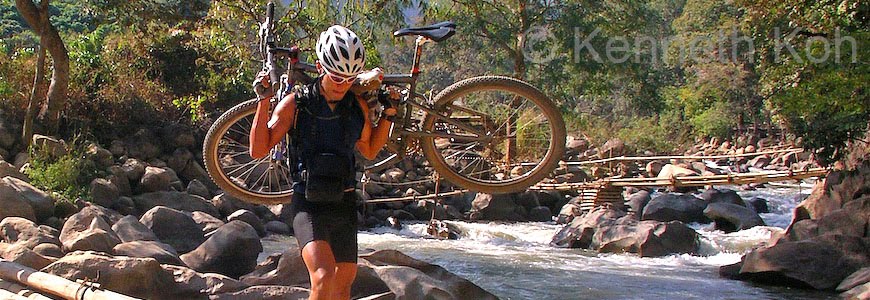Someone asked me what equipment to get for a trek in Nepal. While I was thinking about the list, I thought it would also make in interesting post as a lot of this stuff is also ideal for fast and light adventures. So here's a list of 10 of the best things to get for trekking. Ray: buy everything on this list. Seriously.
1.
Patagonia R1 Hoody
As a base layer for cold temperatures or as a mid layer, the
Patagonia R1 Hoody
rules for it's gridded fleece which is lightweight and dries quicker than than merino wool. The hood and monkey thumbs extend it's usefulness. I find that one or two lightweight fleeces, like this one, are more versatile than a single heavy fleece layer.
 |
| Patagonia R1 Hoody in Black |
2.
MontBell U.L. Down Parka
I won't even look at a down jacket without a hood, and precious few lightweight down jackets come with one. This is one that does. Unlike heavy fleeces which are bulky when packed, this lightweight insulated jacket packs small and lives unobtrusively in your pack until needed in the evenings at camp or the hut. Cons: lightweight fabric is fragile and prone to down leakage.
 |
| Montbell U.L. Down Parka |
3. The North Face Kishtwar I wore this softshell jacket more than any other piece of clothing on Everest. There are two main types of softshells. The first is one made out of a tightly woven fabric, like Schoeller. These are more breathable but less waterproof. The second uses a membrane laminated to the fabric, like Gore Tex. These are less breathable but more waterproof. The Kishtwar uses the latter. It's almost waterproof and, depending on when and where you go, you may not require a more waterproof shell. Size up to make sure you can fit this over your layers.
I wore this softshell jacket more than any other piece of clothing on Everest. There are two main types of softshells. The first is one made out of a tightly woven fabric, like Schoeller. These are more breathable but less waterproof. The second uses a membrane laminated to the fabric, like Gore Tex. These are less breathable but more waterproof. The Kishtwar uses the latter. It's almost waterproof and, depending on when and where you go, you may not require a more waterproof shell. Size up to make sure you can fit this over your layers.
 |
| The North Face Kishtwar Softshell |
|
|
4. The North Face Prophet 52 Backpack Simple, no frills, bombproof. That's how I like my backpacks. No extra compartments or zippers or extraneous stitching or details that can fail or come apart. I carried a Prophet to the top of Mt. Everest. A pack in the 50 liter range is good for a lot of lightweight adventures. They come in sizes. Measure the length of your back to get the right sized harness.
Simple, no frills, bombproof. That's how I like my backpacks. No extra compartments or zippers or extraneous stitching or details that can fail or come apart. I carried a Prophet to the top of Mt. Everest. A pack in the 50 liter range is good for a lot of lightweight adventures. They come in sizes. Measure the length of your back to get the right sized harness.
 |
| The North Face Prophet 52 |
5. Buff Original Headwear
I almost never travel anywhere without one. I did once, and regretted it. It's not only headwear, but a neck scarf, dust filter, wipe sweat, bandanna, pot holder, towel, etc... There are other versions with fleece or merino wool that are not as versatile. Buy the original version.
 |
| Original Buff (Prayer Flag Pattern) |
6. MontBell U.L. Super Spiral Hugger #3 Down Sleeping Bag This sleeping bag is rated to just below freezing. It's compact and light. They are sized for Japanese people, and the Regular fits people up to 6'. That's fine by me - less weight and dead space to warm up. If you are cold, beef up the temperature rating by draping your down jacket over the bag and sleep with a hot water bottle. In Nepal, you can also ask the tea house for a blanket.
This sleeping bag is rated to just below freezing. It's compact and light. They are sized for Japanese people, and the Regular fits people up to 6'. That's fine by me - less weight and dead space to warm up. If you are cold, beef up the temperature rating by draping your down jacket over the bag and sleep with a hot water bottle. In Nepal, you can also ask the tea house for a blanket.
 |
| Montbell U.L. Super Spiral Hugger #3 |
7. Nalgene 16 oz Wide Mouth Water Bottle Forget about hydration bladders unless you are doing something highly active, aerobic or need both hands free. Wide mouth bottles are easier to refill and purify. Get two smaller 16 oz (500ml) bottles. They are easier to fit on the outside pockets of your backpack and hence easier to get a drink than a 32 oz (1 liter) bottle which may need to be stored in the main compartment of your pack.
Forget about hydration bladders unless you are doing something highly active, aerobic or need both hands free. Wide mouth bottles are easier to refill and purify. Get two smaller 16 oz (500ml) bottles. They are easier to fit on the outside pockets of your backpack and hence easier to get a drink than a 32 oz (1 liter) bottle which may need to be stored in the main compartment of your pack.
 |
| Nalgene 16 oz Wide Mouth Bottle |
8. Footwear
I'm hesitant to make specific footwear recommendations. I think it's better to go down to a store to try them on. More important than the brand is the fit. Try them on with the socks you intend to wear. You can adjust the volume a little by changing the insoles. More important is the length. You want very little heel lift, and when you kick your boots, your toes shouldn't be hitting the front of the boot. I've trekked Nepal in everything from tennis shoes to lightweight hikers. You'll be happier in a goretex lightweight hiking boot.
9. Marmot Basic Work Glove I like leather gloves for working. Leather gives better feel, grip and is harder wearing than synthetic. This glove is lined with Driclime and makes a pretty good general purpose outdoor glove. Leather looks cool too, but needs extra care. They shouldn't be washed and should be rubbed with something like mink oil to keep the leather supple and enhance waterproofing.
I like leather gloves for working. Leather gives better feel, grip and is harder wearing than synthetic. This glove is lined with Driclime and makes a pretty good general purpose outdoor glove. Leather looks cool too, but needs extra care. They shouldn't be washed and should be rubbed with something like mink oil to keep the leather supple and enhance waterproofing.
 |
| Marmot Basic Work Glove |
10.Icebreaker Pocket 200 Beanie
I use this beanie more than any other. It's light, packs small, warm for it's weight, and, because it's made from Merino wool, doesn't stink even after a month of use. Combined this with a buff and hooded clothes, and you have a very lightweight, versatile solution for keeping your head warm.
 |
| Icebreaker Pocket 200 Beanie |
I also trek with a pair of nylon zip-off pants, a tech-tee (or two), puffy pants, rain pants, sun hat, sunglasses, couple of underwear and socks, maybe another lightweight fleece top (the idea is that if it is really cold, I can wear all my layers of clothes).
 rules for it's gridded fleece which is lightweight and dries quicker than than merino wool. The hood and monkey thumbs extend it's usefulness. I find that one or two lightweight fleeces, like this one, are more versatile than a single heavy fleece layer.
rules for it's gridded fleece which is lightweight and dries quicker than than merino wool. The hood and monkey thumbs extend it's usefulness. I find that one or two lightweight fleeces, like this one, are more versatile than a single heavy fleece layer.
















No comments:
Post a Comment